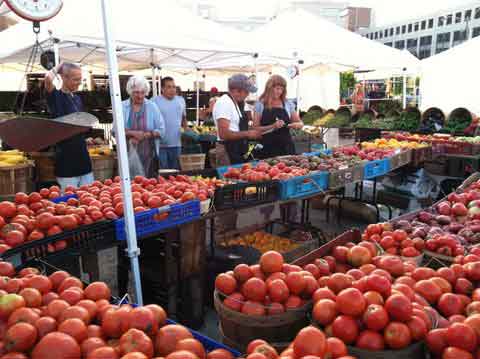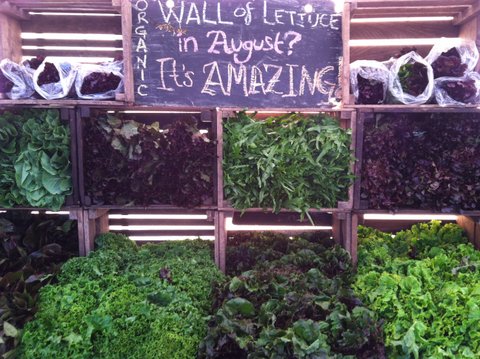
September 2013
Dear Reader,
Can a farmer named Henry teach us as much about market research as all the talking heads at industry meetings? Indeed he can, because he never stops thinking about it in the most direct and immediate ways:
Soon, 3 a.m. is here, and we get up in the darkness one last time and climb into the cab of the big box truck. I always bring a pillow and sleep at least an hour or two en route. Henry drives and thinks and plans. He tells me that no matter how tired he is after the harvest day, he is never tired while driving to market. He’s mentally juggling the more than 100 different vegetables he has in the back of the truck, and thinking about how to display each to its best advantage… in upturned crates—chard with brightly colored stems out, curly green kale with leaves out, bunched choi with fleshy butt ends out, and big white daikon radishes in one crate, rough-looking roots of burdock in another. (from Brockman, The Seasons on Henry’s Farm)
During market season, I work alongside Henry. This quarter we share some of what we have learned from this farmer extraordinaire and keen observer of consumer behavior with an article on earthly lessons for stellar market research.
Other items of interest in this newsletter include:
- A Peek into Big (and Erroneous) Data
- Keep the N.S.A. Out of Our Surveys
- Getting Off the “Best Practices” Bandwagon
- The Slippery Slope of Slider Scales
- Research Cites PR as Honest Abe of Business
- 3 Early Interventions to Make Employees Happy
- Wine Scarcity Drives Consumers to Drink
- Our Top Sources for Innovative Research Ideas
- Ten Things You Can Do with Census Data
- Big Question for Big Data: Does It Work?
- The Surprising Profitability of Product Returns
- Which Conjoint Method Should You Use?
- A Beautiful Chart: Trends in Conjoint Analysis
We are also delighted to share with you:
Here’s to an abundant harvest of research insights this fall!
The Versta Team
From the Ivory Tower to the Farm:
Earthly Lessons for Stellar Market Research
“Let us not forget that the cultivation of the earth is the most important labor of man. When tillage begins, other arts will follow. The farmers, therefore, are the founders of civilization.”
—Daniel Webster
Looking to the Ivory Tower, as we did in our June 2013 Versta Research Newsletter, is not the only place to find amazing insights about marketing and market research. How about looking down? At the ground, I mean, where the earth “laughs a harvest” and all other arts begin? And for this, look no further than Henry Brockman, a savvy and dedicated organic farmer from Congerville, Illinois who is devoted to the earth and to the 1000+ families his farm feeds.

A couple of weeks ago I wrote about shelf scarcity and what makes consumers buy, referencing research published in an academic journal. I kept thinking, “Henry knows exactly what makes his customers buy. His entire enterprise embodies all the elements we strive for as marketing and research professionals: keeping data, talking to customers, learning what works, promoting and teaching, selling a great brand.” Heck, put down those boring academic journals and spend some time with Henry.
On Saturday mornings I am one of a small group of volunteers who hike over to the Evanston Farmer’s Market at 4 a.m. to help Henry unload, set up, and sell hundreds of varieties of vegetables: greens, lettuces, beets, rutabagas, beans, shallots, garlic… an overwhelming abundance of food that customers hungrily assess, pick through, deliberate on, and ultimately decide to buy or not buy. I find there is as much to learn about market research from Henry as there is to learn from the Ivory Tower.
Know Your Data
Besides all the hoeing, seeding, planting, digging, pulling, bundling, crating, and schlepping that Henry does to keep his crops growing, he collects and analyzes a surprising amount of data to figure out what comes next. As Terra Brockman writes in her book, The Seasons on Henry’s Farm (a James Beard prize nominee):
Henry has three field notebooks for the bottom field—one for the east, middle, and west sections—and one for the upper field. Each page is numbered and refers to a specific bed within that portion of the field. Thirty-six beds make up an acre, so Henry has some 360 separate pages to keep track of in his four field notebooks. Over 60 percent of his beds are double-cropped, adding to the complexity of the ecosystem of his fields—and to the complexity of the bookkeeping.
And that is just the beginning. Terra describes his market notebooks in which he tracks how much of every crop he brings to sell, which beds each crop come from, its quality, and how much of it is sold, including how much he gives to volunteers like me. He has “decade diaries” where he documents the weather, farm tasks, beetle damage, weed problems, and so on, all going back to the time he began farming.
What does he use all of this data for? For exactly the same things we use data. To know which products sell and which ones fit best into his expanding and diverse portfolio of crops. There’s the operations side of it, too. Which crops are lost to insects, at what time of year, and in what parts of the field? How should he stagger plantings of arugula so that despite the uncertainty of weather and pests he can offer it throughout the season without relying on chemicals or irrigation?
Most researchers value good data, but rarely do we consider it as comprehensively as we could, or curate it so carefully as we should. We tend to ask questions, get data, and move on. Sometimes we even toss out data, not realizing how it will fit into a bigger picture that can help us analyze success and failure. The lesson from Henry is to think both big and small with data, document everything, and keep doing it, because data sets the crucial foundation for smart decisions.
Know Your Customers
I know of no focus group moderator, mystery shopper, or consumer products ethnographer who pays closer attention to how customers move, behave and deliberate than Henry. Without ever stopping his work (selling produce, re-stocking and shifting goods as they sell, plus managing volunteers like me) he notices where his customers gravitate within the stand and sets our selling stations accordingly. If I stand inside a ring of tables overflowing with tomatoes, people (and money) gravitate towards me. That gets balanced with volunteers along the perimeter—one by the Japanese greens and lettuces, another by the herbs and alliums—to keep an open flow for shopping.
Where does shelf scarcity fit in? “Customers want abundance,” says Henry. “The more they see, the more they buy.” So one part of our job is to make the food look always abundant, restocked and overflowing. As produce runs out, we consolidate space and combine, removing crates and tables as more and more is sold. No sooner do we get everything set up, than the entire stand starts magically shrinking from six tents and 20 tables and hundreds of boxes and baskets of produce, to five tents, then four, until we have just one tent and two tables at the end of the morning—but those two tables look as abundant and beautiful as the 20 tables did at the start of the day.

As researchers, we often rely on data that is far removed from what it represents. So it is critical (but unfortunately not common) for researchers—no matter how far removed from data collection—to get on the phone with research respondents, observe focus groups, or find other ways to learn directly from customers whose behaviors and attitudes are captured in our data. The lesson from Henry is to get outside of our data. Talk with customers and observe what they do to help interpret and understand what the data mean and what drives outcomes.
Know Your Mission
Of course data and research only matter if they help us make good decisions, which (should!) happen within the context of a clear mission. Data never speak for themselves, which is one reason why turning data into stories is so important.
Here Terra describes what happens in December when Henry assimilates his first-hand knowledge of customers with all that carefully recorded data:
You may think that Henry would drop the low-gross-revenue crops or varieties—but you would be wrong. Henry’s goal is always diversity—the kind of diversity that mimics nature and keeps pests guessing; the kind of diversity in which one crop removes nutrients from the soil, and another puts them back; the kind of diversity that yields not only a healthy farm but also a healthy bank account…. He only eliminates things that don’t grow well or taste good. If something does grow well and taste good, but doesn’t sell well, Henry may put it on the bench for a few years. But out of sheer perseverance and the conviction that there’s an audience out there for any good vegetable, no matter how unfamiliar, Henry generally succeeds in reinstating it. New Zealand spinach, Malabar spinach, and bitter melon are examples of vegetables he dropped for a few seasons, only to restore and have them work out later.
Bigger questions and goals, specific to the needs of our clients’ own businesses should drive our market research, data collection, interpretation, and the findings derived from it. In our experience, that is the kind of research that gets clients excited. Instead of wondering what to do with data and why so much is spent on tracking KPIs and NPSs and other “metrics” pitched by this marketing expert or that, they get real answers to questions that help them towards their mission.
Getting Our Hands Dirty
In short, Henry Brockman reminds me that the best market research, like the best farming, requires deep involvement in all phases of work. Great research requires being in the field, designing and overseeing data collection. It requires personally talking with consumers and prospects and decision makers, digging for all the “why’s” behind the data. It requires even the most senior researchers to be analyzing and wrangling with data before it ever shows up in a spreadsheet so that we can answer specific questions our clients have, not the usual questions that assume all missions are the same.
Great research means getting our hands dirty, like farmers in the field, to offer up a harvest of abundant insights that keeps colleagues and customers coming back for more.
Stories from the Versta Blog
Here are several recent posts from the Versta Research Blog. Click on any headline to read more.
A Peek into Big (and Erroneous) Data
We suggest thinking twice before appending data for market research from commercial data aggregators. A peek behind the curtain suggests the data is not so good.
Keep the N.S.A. Out of Our Surveys
Government spying on U.S. citizens will likely erode trust among the respondents we rely on for research data. Our industry needs to reaffirm a commitment to absolute privacy.
Getting Off the “Best Practices” Bandwagon
Sometimes “best practices” are not so great if not implemented with an eye towards solving a problem. We learned that the hard way with our newsletter.
The Slippery Slope of Slider Scales
Slider scales for online surveys are a great way to build a more interactive experience for respondents, but there are some big dangers to watch out for as well.
Research Cites PR as Honest Abe of Business
New research shows PR professionals to be intensely focused on providing an independent view and telling true stories for the organizations they serve—just like market research.
3 Early Interventions to Make Employees Happy
Dilbert’s search for meaning should be much easier with new research documenting simple steps companies can take from before new employees even sign on.
Wine Scarcity Drives Consumers to Drink
Recent research on purchasing behavior shows that poorly stocked shelves actually drive consumer purchase for less familiar food brands and products.
Our Top Sources for Innovative Research Ideas
Besides academic journals, here are nine more resources we read religiously for ideas, insights, and inspiration about marketing, communications, and research.
Ten Things You Can Do with Census Data
The Census does more than count people—it measures our civic and economic lives in surprising ways that provides a foundation for businesses like yours to succeed.
Big Question for Big Data: Does It Work?
With all the breathless excitement about big data transforming business, a big question remains as to whether all the fancy algorithms truly make a difference.
The Surprising Profitability of Product Returns
It may seem like product returns hurt your bottom line, but research shows that generous return policies get customers to try and buy products they would otherwise avoid.
Which Conjoint Method Should You Use?
Discrete choice modeling is the most popular conjoint method used in market research, but there are lots of research questions for which it is not the best choice.
A Beautiful Chart: Trends in Conjoint Analysis
The software package R is a better choice than PowerPoint for charting time-series data, as we illustrate with data about trends in conjoint software usage.
Versta Research in the News
Survey: College Faculty Are Delaying Retirement
Research for Fidelity Investments has been featured on CNN, Bankrate, and other media outlets.
MORE VERSTA NEWSLETTERS

